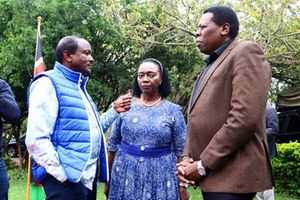'Bring me cows and take her away’; long road to ending FGM

A newly married 14-year-old girl in Marsabit County on September 21, 2022. With ravaging drought, households in this northeastern county are trading off underage girls for three camels.
What you need to know:
- In 2019, Kenya committed to eliminating female genital cutting by the end of this year and efforts were put in place and resources allocated.
- However, 29 days to the year’s end, the harmful practice is still rearing its head, with many girls being subjected to untold suffering in hotspot counties
"Kenya commits to eliminating female genital mutilation (FGM) by 2022." These were former President Uhuru Kenyatta’s words at a Women Deliver Conference in Vancouver, Canada, in 2019.His statement meant that by the end of his term, August, 2022, Kenya would have no more of new cases of FGM.
But did his administration meet the target? Only last month, a couple in Leparua, Isiolo County, was arrested for allegedly subjecting their six-month-old daughter to the cut.
In April, seven suspects were arrested in Nyeri for conducting FGM. The decades-old tradition remains rampant in this era despite its prohibition in 2011.
Ms Everlyne Maloi recalls that although she had put up a spirited fight against undergoing FGM when she was 15, she eventually had to cave in to her family’s demands.
“My father struggled to educate us. I had been home for a year waiting for him to raise school fees for me to join secondary, with little luck. My relatives thought my father was ‘sitting on a goldmine’ by not simply circumcising and marrying me off,” she tells Nation.africa.
She evaded circumcision earlier because she secured a full academic scholarship at Saint Bonaventure Girls High School in Migori County. Were it not for this small miracle, she would have been married off after Class Eight.
Six years later, after sitting her KCSE exam, she was at home waiting for university placement when her parents rekindled their intentions to have her circumcised and married off.
Although she had scored a B- , her father could not afford to take her to university because he was already struggling to raise her eight siblings.
Curse threat
“My parents told me that in Maasai culture, ‘big girls’ get circumcised. It is what our culture demands. I was made to understand that if I refused, I would bring shame to my family and expose them to ridicule. My father also said he would curse me, so I accepted,” Ms Maloi reminisces.
Fortunately, after she underwent the cut, a local human rights defender took her to a rescue centre before her parents could marry her off. She is now waiting to join university where she hopes to pursue a Bachelor of Education.
Chief Joseph Lekanayia of Selenge Sub-location in Kajiado County tells Nation.Africa that although FGM and early marriage prevalence in Kajiado has significantly decreased over the years, more advocacy needs to be done to shift cultural perspectives of locals.
“We have built a good rapport with the community so that we can monitor and prevent incidents of FGM and child marriages.
“Community activities, such as leadership programmes for girls during long school holidays, assist in preventing these abuses because they cannot be sneaked away to be circumcised or married,” Mr Lekanaiya says.
Fighting FGM is a no mean task, complicated by poverty, drought, adherence to the discriminatory cultural practices, and relatives moving girls across the counties and into the neighbouring countries for the cut.
FGM is prevalent in Kenya’s 22 counties, including Kajiado, Narok, Samburu, Laikipia, Migori, Kisii, Nyamira, Meru and Embu. The others are Mandera, Wajir, Garissa, Tana River, West Pokot, Baringo, Elgeyo Marakwet, Isiolo, Marsabit, Bungoma, Bomet and Taita Taveta.
“Here (West Pokot), there are cases where chiefs abet FGM and child marriage. They will say ‘What is the problem? Go bring me cows and take her away’” explains Caroline Menach, the principal of St Elizabeth Girls’ Secondary School.
Also read: Why Uhuru's FGM deadline may not be met
And for fear of the local administration surrendering them to their relatives or sealing the forced marriage, girls have found refuge in schools.“Girls now prefer to run to schools for rescue and that is how, for instance, a rescue centre in Morpus Primary School came to be,” she says.
Hurdles
In June 2021, then United Nations Population Fund Kenya representative Ademola Olajide expressed concern that duty bearers were making it difficult to end FGM.
He said: “It is the duty bearers who are yet to internalise their role in combating FGM. Here, I am talking about people who have the responsibility to protect women and girls, but find it hard to do so because of their cultural affinity.”
They, therefore, make excuses for their communities instead of doing the right thing. These are, for example, chiefs, assistant chiefs and health workers.
They will begin going towards the right direction, once their mind-set shifts. “In Marsabit, one of the 23 arid and semi-arid counties ravaged by drought, parents are pulling their girls out of school to trade them off for livestock or money.”
The more these families are affected by the drought, the more their girls stop learning and are married off to old men in exchange for cows.
In Marsabit, FGM precedes marriage and the practice is seasonal but because the girls have to be, suddenly they break the pattern by cutting them at the point of need and give them away,” says National Drought Management Authority Drought Coordinator in Marsabit County Parkolwa Mustafa.
According to the 2014 Kenya Demographic and Health Survey (KDHS), 21 per cent of women and girls aged between 15 and 49 had undergone the cut.
In some communities, however, the practice is four times the national prevalence.
Among the Somali, for instance, prevalence stood at 94 per cent, meaning nearly all girls and women had been circumcised.
It was 86 per cent in Samburu, 84 per cent in Kisii and 78 per cent among Maasai.“It is no longer about the board working alone. We now have many other players.
“We have adopted a multi-sectoral approach,” Anti-FGM Board Chief Executive Officer Bernadette Loloju said in an earlier interview.
On meeting the 2022 target she said: “You know FGM can end the same way people have stopped shaking hands. People will wake up one day and say we will not do it anymore. It is just about changing the mind-set.”
One of the threats to anti-FGM fight is health professionals abetting the crime.
Ms Loloju, however, indicated they had a counter-strategy. “We are directly dealing with the nurses through the Nursing Council and any nurse found culpable will face the law just like anyone else,” she said.
Despite well-documented negative effects of FGM, some African countries where women and girls are at risk of undergoing the ‘cut’ have not criminalised FGM.
African outlook
In West Africa, Liberia, Mali and Sierra Leone have not enacted national laws that prohibit FGM. In Eastern Africa, Sudan only passed a law criminalising FGM in 2020, while Somalia only mentions FGM in its constitution, but does not have a national law that prohibits it.
According to the 2019 Sierra Leone Demographic Health Survey, 83 per cent of women between 15-49 years have undergone FGM, a slight decrease from a 90 per cent prevalence in 2013.
Moreover, Sierra Leone has an officially registered community-based organisation—the Sierra Leonean Women are Free to Choose Community (SLWA-FC).
According to its online profile, the organisation aims to advance the rights of circumcised women and girls and resist anti-FGM campaigns.
The Executive Director of SLWAFC, Dr Fuambai Sia Ahmadu, stated in a previous interview: “I was born from a circumcised woman, who was born from a circumcised woman and so on.
“To agree to the term ‘mutilation’ is to curse not only the private parts of my mother and grandmother, but the very source of my life, identity and ancestry.’’
Nice Leng’ete, a human rights activist and anti-FGM champion based in Kimana, Loitoktok, says FGM is an important cultural aspect of practising communities that would take multi-dimensional approach to eradicate.
“The government must also take into account that FGM is also a source of income for traditional cutters. A structural approach should be adopted whereby alternative channels of income are provided so that the cutters do not think of going back to practising FGM,’’ Ms Leng’ete says.
In 2018, Kenya, Uganda and Tanzania had, under the facilitation of UNFPA-United Nations Children’s Fund (Unicef) Joint Programme on the Elimination of FGM, agreed to collectively combat the vice during an international conference on ending FGM held in Ouagadougou, Burkina Faso.
There were representatives from ministries of Gender from the respective countries.
Kenya later reached out to Somalia and Ethiopia, resulting in the April 2019 adoption of the declaration and action plan to end cross-border FGM during an inaugural regional inter-ministerial meeting held in Mombasa, Kenya.
According to former Gender Cabinet Secretary Prof Margaret Kobia, the pact saw a decline in new cases of cross-border FGM due to strengthened surveillance.
On the Kenya-Tanzania border, for instance, girls are moved across by motorcycles and it’s impossible to tell the mission of their travel since they have relatives in Tanzania.
While conducting an investigation into cross-border FGM in 2021, Tanzania’s Inspector Paul Kimassa had said it was difficult to tell the data on Kenyan girls brought into the country for the cut.
He says the deep secrecy in which cross-border FGM is done and the locals’ conspiracy to abet the crime, complicates monitoring of the criminal activity.
“The people prefer to avoid reporting these cases to remain in good books with their neighbours,” he says.
Whether the prevalence has declined or increased from 21 per cent is a question the government has yet to answer.
From many anti-FGM champions, the anecdotal evidence indicates Kenya is still on a crawling stage in the course to zero FGM.
All Kenya has now is evidence in the form of a farewell letter to the staff, by former Cabinet Secretary for the Ministry of Interior and Coordination of National Government Dr Fred Matiang’i in which he indicated that through concerted efforts, the triple threats of FGM, teenage pregnancies and sexual violence had, during the Uhuru administration, been tamed to an “all-time low”.
But how low are the missing statistics?





